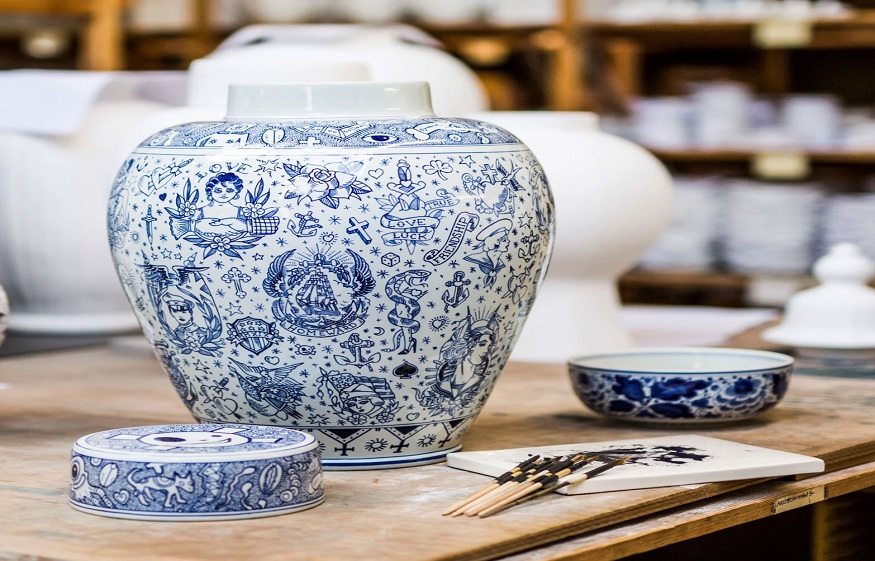 Delft pottery, also known as Delftware, has a rich history that dates back to the 17th century in the Netherlands. The origins of this distinctive blue and white ceramic can be traced to the city of Delft, where artisans sought to replicate the fine porcelain that was being imported from China. At the time, Chinese porcelain was highly prized in Europe, but its availability was inconsistent due to trade disruptions. Dutch potters, inspired by the imported wares, began experimenting with tin-glazed earthenware to create their own version of the sought-after porcelain.
Delft pottery, also known as Delftware, has a rich history that dates back to the 17th century in the Netherlands. The origins of this distinctive blue and white ceramic can be traced to the city of Delft, where artisans sought to replicate the fine porcelain that was being imported from China. At the time, Chinese porcelain was highly prized in Europe, but its availability was inconsistent due to trade disruptions. Dutch potters, inspired by the imported wares, began experimenting with tin-glazed earthenware to create their own version of the sought-after porcelain.
The Rise of Delft as a Pottery Centre
During the Dutch Golden Age, Delft became a leading centre for pottery production. The city was already known for its skilled artisans, and by the mid-1600s, it housed numerous pottery workshops. The introduction of tin glaze allowed potters to achieve the smooth, white surface that closely resembled Chinese porcelain. Over time, Delftware developed its own distinct character, incorporating European influences alongside traditional Chinese motifs. The designs typically featured intricate floral patterns, landscapes, and scenes of daily life, often painted in striking cobalt blue.
The Influence of Chinese and European Styles
The earliest Delftware was directly inspired by the blue and white porcelain of the Ming dynasty. Dutch potters imitated the patterns and styles seen in imported Chinese pieces, but as Delftware grew in popularity, local artisans began to introduce European elements into their designs. Scenes depicting Dutch countryside landscapes, naval battles, and biblical stories became common, reflecting the cultural and artistic trends of the Netherlands at the time. Over the years, Delft pottery evolved from being a mere imitation of Chinese porcelain to an art form that blended Eastern and Western influences.
The Peak of Delftware Production
By the late 17th century, Delftware had become a symbol of wealth and refinement. The demand for these ceramics was high across Europe, leading to the establishment of around thirty pottery factories in Delft. The most famous of these was De Porceleyne Fles, founded in 1653, which remains in operation today. The factories produced a wide range of items, including plates, vases, tiles, and even decorative objects shaped like animals and figurines. Royal commissions and the patronage of the Dutch elite helped further elevate the status of Delft pottery.
The Decline of Delft Pottery
Despite its success, Delftware began to decline in the 18th century due to competition from new ceramic techniques. The development of hard-paste porcelain in Germany and England offered a more durable alternative that quickly gained favour among European consumers. Factories in Meissen, Sèvres, and Staffordshire began producing porcelain that was more resistant to chipping and breaking compared to tin-glazed earthenware. As a result, many Delft pottery workshops closed, and by the 19th century, only a few remained in operation.
The Revival of Delftware
Interest in Delft pottery saw a revival in the late 19th and early 20th centuries, driven by a renewed appreciation for traditional craftsmanship. The Arts and Crafts movement, which emphasised handmade goods and historical techniques, helped bring attention back to Delftware. De Porceleyne Fles, one of the few surviving Delft factories, played a key role in preserving the tradition and adapting it to modern tastes. The factory introduced new designs and techniques while maintaining the signature blue and white aesthetic that had made Delft pottery so iconic.
Delft Pottery Today
Today, Delft pottery remains an important part of Dutch heritage. Collectors and enthusiasts continue to seek out antique Delftware, while contemporary artisans create new pieces that honour the traditional methods. Museums in the Netherlands, such as the Rijksmuseum in Amsterdam and the Royal Delft Museum in Delft, showcase stunning collections of historical Delft pottery, highlighting its artistic and cultural significance. The legacy of Delftware endures as a testament to the ingenuity and craftsmanship of Dutch potters, ensuring that this centuries-old tradition continues to be appreciated around the world.



